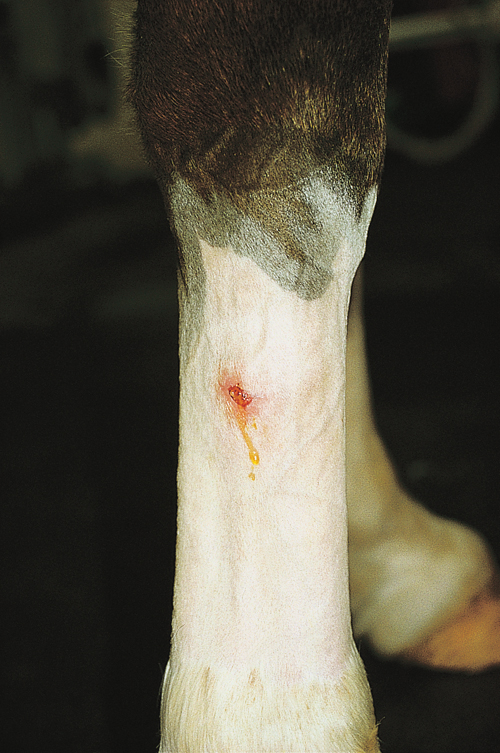Difference between revisions of "Equine Orthopaedics and Rheumatology Q&A 12"
| (One intermediate revision by one other user not shown) | |||
| Line 13: | Line 13: | ||
|a1=Infective (septic) osteomyelitis of the fourth metacarpal bone secondary to a contaminated, open fracture of this structure. <br><br> | |a1=Infective (septic) osteomyelitis of the fourth metacarpal bone secondary to a contaminated, open fracture of this structure. <br><br> | ||
At this stage, radiography would reveal irregular radiolucent areas surrounding the fracture associated with florid periosteal new bone formation. (A foreign body is a less likely possibility.) | At this stage, radiography would reveal irregular radiolucent areas surrounding the fracture associated with florid periosteal new bone formation. (A foreign body is a less likely possibility.) | ||
| − | |l1= | + | |l1=Osteomyelitis |
|q2=How would you treat this case? | |q2=How would you treat this case? | ||
|a2= | |a2= | ||
Surgical excision of the infected portion of bone in combination with a course of systemic antibiotics, ideally selected on the basis of the sensitivity of organisms cultured from the depths of the wound. | Surgical excision of the infected portion of bone in combination with a course of systemic antibiotics, ideally selected on the basis of the sensitivity of organisms cultured from the depths of the wound. | ||
| − | |l2= | + | |l2=Osteomyelitis#Treatment |
|q3=With the benefit of hindsight, could the case have been managed more effectively? | |q3=With the benefit of hindsight, could the case have been managed more effectively? | ||
|a3= Yes. Radiographic examination of the region at the time of injury would have revealed damage to the fourth metacarpal bone and the risk of infective osteomyelitis could have been anticipated. <br><br> | |a3= Yes. Radiographic examination of the region at the time of injury would have revealed damage to the fourth metacarpal bone and the risk of infective osteomyelitis could have been anticipated. <br><br> | ||
Debridement and lavage of the wound with the horse standing, under sedation, and a course of systemic, broad-spectrum antibiotics may have prevented infection becoming established within the bone. | Debridement and lavage of the wound with the horse standing, under sedation, and a course of systemic, broad-spectrum antibiotics may have prevented infection becoming established within the bone. | ||
|l3= Osteomyelitis | |l3= Osteomyelitis | ||
| − | |||
</FlashCard> | </FlashCard> | ||
Latest revision as of 23:44, 3 August 2011
| This question was provided by Manson Publishing as part of the OVAL Project. See more Equine Orthopaedic and Rheumatological questions |
A horse was at pasture with other horses when it was found with a large soft tissue swelling, associated with a small skin wound, over the proximo-lateral aspect of the metacarpus, six weeks previously. A short course of potentiated sulphonamides was prescribed, but the wound failed to heal.
| Question | Answer | Article | |
| What is the most likely cause of the persistent discharge, and how would you confirm your diagnosis? | Infective (septic) osteomyelitis of the fourth metacarpal bone secondary to a contaminated, open fracture of this structure. At this stage, radiography would reveal irregular radiolucent areas surrounding the fracture associated with florid periosteal new bone formation. (A foreign body is a less likely possibility.) |
Link to Article | |
| How would you treat this case? | Surgical excision of the infected portion of bone in combination with a course of systemic antibiotics, ideally selected on the basis of the sensitivity of organisms cultured from the depths of the wound. |
Link to Article | |
| With the benefit of hindsight, could the case have been managed more effectively? | Yes. Radiographic examination of the region at the time of injury would have revealed damage to the fourth metacarpal bone and the risk of infective osteomyelitis could have been anticipated. Debridement and lavage of the wound with the horse standing, under sedation, and a course of systemic, broad-spectrum antibiotics may have prevented infection becoming established within the bone. |
Link to Article | |
